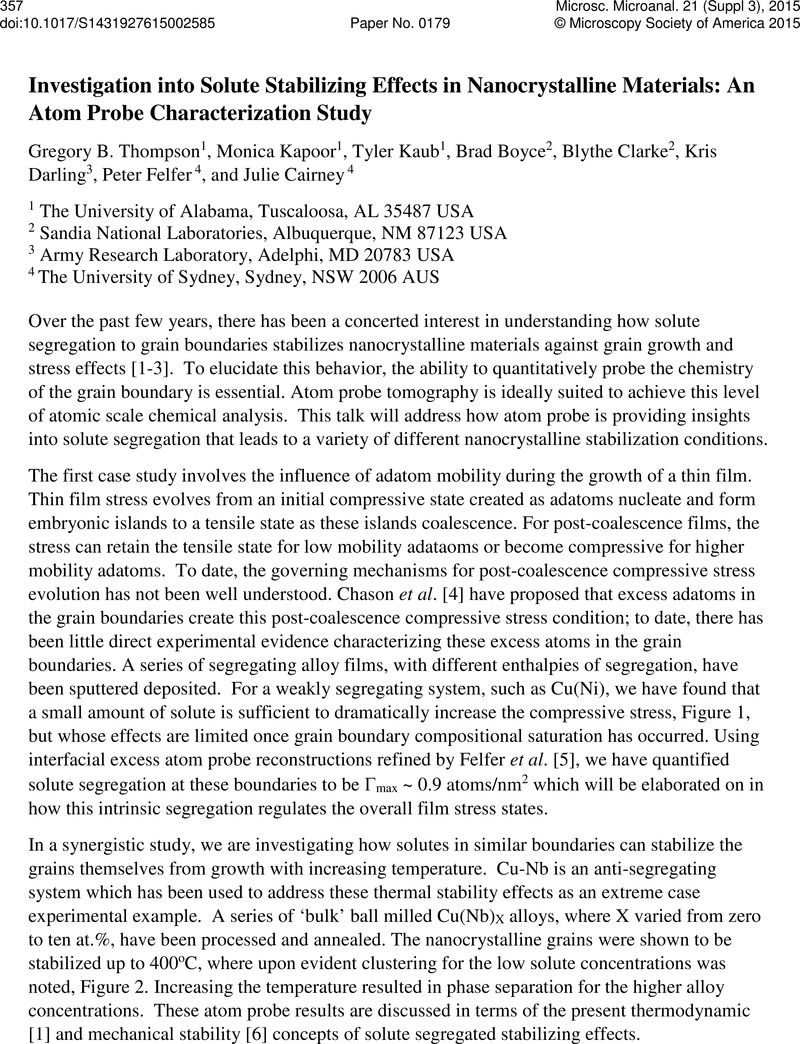No CrossRef data available.
Article contents
Investigation into Solute Stabilizing Effects in Nanocrystalline Materials: An Atom Probe Characterization Study
Published online by Cambridge University Press: 23 September 2015
Abstract
An abstract is not available for this content so a preview has been provided. As you have access to this content, a full PDF is available via the ‘Save PDF’ action button.

- Type
- Abstract
- Information
- Microscopy and Microanalysis , Volume 21 , Supplement S3: Proceedings of Microscopy & Microanalysis 2015 , August 2015 , pp. 357 - 358
- Copyright
- Copyright © Microscopy Society of America 2015
References
References:
[1]
Murdoch, H. A. & Schuh, C. A.. Stability of binary nanocrystalline alloys against grain growth and phase separation. Acta Materialia
61 (2013) 2121–2132.CrossRefGoogle Scholar
[2]
Tang, F., Gianola, D.S., Moody, M.P., Hemker, K.J. & Cairney, J.M., ""Observations of grain boundary impurities in nanocrystalline aluminum and their influence on microstructural stability and mechanical behavior,". Acta Materialia
60 (2012) 1038.CrossRefGoogle Scholar
[3]
Fu, B. & Thompson, G. B.. Compositional dependent thin film stress states. Journal of Applied Physics
108 (2010). 043506-1-6..Google Scholar
[4]
Chason, E., Sheldon, B., et al.., Origin of compressive residual stress in polycrystalline thin films. Physical Review Letters
88 (2002). 156103-1-4..CrossRefGoogle ScholarPubMed
[5]
Felfer, P., Ceguerra, A., Ringer, S. & Cairney, J.. Applying computational geometry techniques for advanced feature analysis in atom probe data. Ultramicroscopy
132 (2013) 100–106.CrossRefGoogle ScholarPubMed
[6]
Darling, Darling K. A., VanLeeuwen, B. K., et al.., Stabilized nanocrystalline iron-based alloys: Guiding efforts in alloy selection. Materials Science and Engineering: A
528 (2011) 4365–4371.Google Scholar
[7] GBT and TK acknowledge the AR0-W911NF1310436 grant; MK, BB and BC recognize The U.S. Department of Energy, Office of Science, Basic Energy Sciences, Materials Sciences and Engineering Division for support. Sandia National Laboratories is a multi-program laboratory managed and operated by Sandia Corporation, a wholly owned subsidiary of Lockheed Martin Corporation, for the U.S. Department of Energy's National Nuclear Security Administration under contract DE-AC04-94AL85000.Google Scholar


